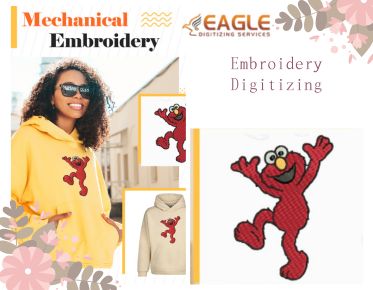Unleash Success_ Launching Your Hat Embroidery Business
Why Hat Embroidery is a Hot Business Opportunity
In recent years, hat embroidery has
surged in popularity, transforming from a niche craft to a lucrative business
opportunity. This trend owes its rise to the growing demand for personalized
fashion and the timeless appeal of custom-designed apparel. With minimal
startup costs and the potential for high-profit margins, hat embroidery offers
a perfect entry point for creative entrepreneurs. If this post spurred your
interest and you want to find out more about Embroidery Digitizing, please feel free to contact us.
The Rise of Custom Embroidery in
Fashion
Custom embroidery has become a staple in the fashion industry, with both high-end designers and everyday consumers seeking unique, personalized items. Embroidered hats, in particular, have become a symbol of individuality and style. The ability to add distinctive logos, names, and artistic designs to headwear allows for endless customization, catering to a wide range of tastes and preferences.
Getting
Started with Hat Embroidery
Understanding the Basics of
Embroidery
Embroidery is the art of decorating fabric using needle and thread, a
practice that dates back centuries. For hat embroidery, understanding the
basics is crucial. It involves mastering various stitches and techniques to
create patterns on different types of fabric. Key to this craft is precision
and patience, ensuring that each stitch contributes to the overall design.
Essential Tools and Equipment
for Hat Embroidery
Starting a hat embroidery business requires some essential tools and equipment. First and foremost, you'll need a good quality embroidery machine, preferably one designed for hats. Other necessary tools include a variety of needles, high-quality threads, stabilizers to keep the fabric taut and digitizing software to convert your designs into embroidery files. A comfortable workspace and proper lighting are also essential to maintain efficiency and reduce eye strain.
Choosing
the Right Hats for Embroidery
Popular Hat Styles for
Embroidery
When selecting hats for embroidery, consider popular styles that
appeal to a broad audience. Baseball caps, trucker hats, snapbacks, and beanies
are among the top choices. Each style offers a unique canvas for your designs,
with baseball caps and snapbacks providing ample front panel space, while
beanies offer a cozy, winter-ready option.
Quality vs. Cost: Finding the
Perfect Balance
Balancing quality and cost is crucial when sourcing hats for your business. While it might be tempting to opt for the cheapest options, investing in higher-quality hats will ensure better durability and customer satisfaction. Look for hats made from sturdy materials that can withstand the embroidery process without warping or tearing.
Designing
Your Embroidery Patterns
Tips for Creating Eye-Catching
Designs
Creating eye-catching designs is at the heart of a successful hat
embroidery business. Start by drawing inspiration from current trends, nature,
art, and even pop culture. Focus on creating clean, bold lines and vibrant
colors that stand out. Simplicity often works best, especially for small
surfaces like hats. Keep your designs versatile to appeal to a wider audience.
Using Software to Digitize Your
Artwork
Digitizing your artwork is the process of putting your designs into an embroidery machine-readable format. There are various software options available that can help you with this task. These programs allow you to map out stitch types, directions, and sequences, ensuring that your design is embroidered accurately and efficiently.
Setting
Up Your Workspace
Creating an Efficient and
Comfortable Work Area
A well-organized workspace can significantly impact your productivity
and creativity. Ensure your area is well-lit, with a comfortable chair and a
sturdy table for your embroidery machine. Keep your tools and materials within
easy reach, and maintain a tidy environment to avoid unnecessary stress and
delays.
Organizing Your Supplies and
Equipment
Efficient organization of your supplies and equipment is essential for smooth operation. Use storage bins, shelves, and drawers to keep threads, needles, stabilizers, and other materials neatly sorted. Label everything clearly to save time and reduce frustration when looking for specific items.
Sourcing
Quality Materials
Where to Buy Blanks and
Embroidery Threads
Sourcing quality materials is fundamental to producing top-notch
embroidered hats. Look for reputable suppliers that offer a wide range of blank
hats and embroidery threads. Online marketplaces, specialty embroidery shops,
and trade shows are excellent places to start. Building relationships with
reliable suppliers can also lead to bulk discounts and better service.
Selecting the Best Materials for
Durability and Appeal
When choosing materials, prioritize durability and aesthetic appeal. High-quality threads should be strong and colorfast to withstand washing and wear. Similarly, select hats made from robust fabrics that maintain their shape and color over time. Your reputation depends on the longevity and look of your finished products.
Mastering
Embroidery Techniques
Step-by-Step Guide to Basic
Embroidery Stitches
Mastering basic embroidery stitches is the foundation of creating
beautiful designs. Start with the running stitch, backstitch, and satin stitch.
These simple stitches can create outlines, fill areas, and add intricate
details. Practice regularly to perfect your technique and gain confidence in
your skills.
Advanced Techniques to Elevate
Your Designs
Once you’ve mastered the basics, explore advanced techniques to elevate your designs. Techniques like 3D puffembroidery, applique, and gradient stitching can add depth and texture to your creations. Experiment with different methods to find what best suits your style and the needs of your clients.
Creating
Your First Embroidered Hat
From Concept to Finished Product
Creating your first embroidered hat involves several steps, from
conceptualizing your design to the final stitch. Start with a clear design
plan, digitize it using embroidery software, and select the appropriate thread
colors. Set up your machine, ensure the hat is properly hooped, and begin the
embroidery process. Take your time and check your progress frequently to ensure
quality.
Troubleshooting Common Issues
Embroidery can come with its share of challenges. Common issues include thread breaks, uneven stitching, and fabric puckering. Troubleshoot these problems by ensuring your machine is properly maintained, using the right needle and thread, and adjusting the tension settings as needed. Practice and patience are key to overcoming these hurdles.
Building
Your Brand
Developing a Unique Brand
Identity
A solid brand identity distinguishes your business from its
competitors. Define what makes your embroidery unique and communicate this
through your brand name, logo, and tagline. Consistency in your branding helps
build recognition and trust among your customers.
Creating a Memorable Logo and
Tagline
Your logo and tagline should encapsulate the essence of your business. A memorable logo is simple yet distinctive, while your tagline should be concise and reflective of your brand's values and vision. These elements will appear on your website, social media, and marketing materials, so they must leave a lasting impression.
Setting
Your Prices
How to Price Your Hats for
Profit
Pricing your embroidered hats requires a careful balance between cost
and profit. Calculate your total costs, including materials, labor, and
overhead, then add a markup that reflects the quality and uniqueness of your
work. Research competitors’ pricing to ensure your rates are competitive while
still providing value to your customers.
Understanding Your Costs and
Margins
Understanding your costs and margins is crucial for financial sustainability. Track all expenses meticulously and regularly review your pricing strategy. Ensure that your margins are sufficient to cover all costs and provide a healthy profit. This financial insight will help you make informed business decisions.
Marketing
Your Hat Embroidery Business
Crafting an Effective Marketing
Plan
An effective marketing plan is essential for attracting customers and
growing your business. Identify your target audience and personalize your
marketing strategies to reach them. Utilize a mix of online and offline
strategies, including social media, email marketing, and local events, to
increase your visibility and drive sales.
Utilizing Social Media to Grow
Your Audience
Social media platforms are powerful tools for promoting your hat embroidery business. Share high-quality images of your work, behind-the-scenes content, and customer testimonials to engage with your audience. Use targeted ads and collaborations with influencers to expand your reach and attract new customers.
Selling
Your Embroidered Hats
Online Marketplaces to Sell Your
Products
Selling your embroidered hats online opens up a vast market. Platforms
like Etsy, eBay, and Amazon Handmade are great places to start. These
marketplaces provide a built-in audience and tools to help you manage your
sales. Ensure your product listings are detailed and visually appealing to
attract buyers.
Setting Up Your Own E-Commerce
Store
Creating your own e-commerce store gives you complete control over your brand and customer experience. Set up your store with systems such as Shopify, WooCommerce, or BigCommerce. Invest in professional photography, write compelling product descriptions, and optimize your site for search engines to attract organic traffic.
Networking
and Building Relationships
Partnering with Local Businesses
and Influencers
Building relationships with local businesses and influencers can boost
your brand’s visibility. Partner with boutiques, gift shops, and apparel stores
to feature your hats. Collaborate with influencers to showcase your products to
their followers, increasing your reach and credibility.
Joining Embroidery and Craft
Communities
Joining embroidery and craft communities, both online and offline, can provide valuable support and inspiration. Participate in forums, attend local craft fairs, and engage with fellow crafters. These communities offer opportunities for learning, networking, and collaboration.
Offering
Custom Orders
How to Handle Custom Design
Requests
Handling custom design requests can be both rewarding and challenging.
Communicate clearly with customers to understand their vision and provide
guidance on what is feasible. Create detailed mockups and obtain approval
before starting the embroidery process to ensure satisfaction.
Tips for Managing Customer
Expectations
Managing customer expectations is key to maintaining satisfaction. Be transparent about your capabilities, timelines, and pricing. Set realistic deadlines and keep customers informed throughout the process. Clear communication promotes trust and decreases the possibility of misunderstandings.
Expanding
Your Product Line
Introducing New Hat Styles and
Accessories
Expanding your product line keeps your offerings fresh and appealing.
Introduce new hat styles, such as bucket hats, visors, or fedoras. Consider
adding complementary accessories like embroidered patches, tote bags, or
apparel to diversify your product range and attract more customers.
Adding Complementary Products to
Increase Sales
Complementary products can boost your sales and enhance customer loyalty. Think beyond hats and offer items like embroidered keychains, wallets, or home décor. Bundling related products together can also increase your average order value and provide more options for gift shoppers.
Staying
Inspired and Motivated
Finding Inspiration for New
Designs
Inspiration can come from many sources, including nature, art, travel,
and everyday life. Keep a sketchbook or digital folder to collect ideas and
reference materials. Experiment with new techniques and styles to keep your
designs fresh and exciting.
Overcoming Creative Blocks
Creative blocks are a common challenge for artists. When you’re
feeling stuck, take a break, seek inspiration from new sources, or try a different
creative activity. Sometimes, stepping away from your work for a bit can help
you return with fresh ideas and renewed motivation.
Launching a profitable hat embroidery business
is a journey filled with creativity, challenges, and rewards. Reflect on
how far you’ve come, the skills you’ve developed, and the milestones you’ve
achieved. Each step forward is a reflection of your hard work and perseverance.
As you continue your embroidery journey, remember to keep growing and
innovating. Embrace new techniques, explore different markets, and never stop
learning. The world of embroidery is vast and full of opportunities, so stay
curious and passionate about your craft.



